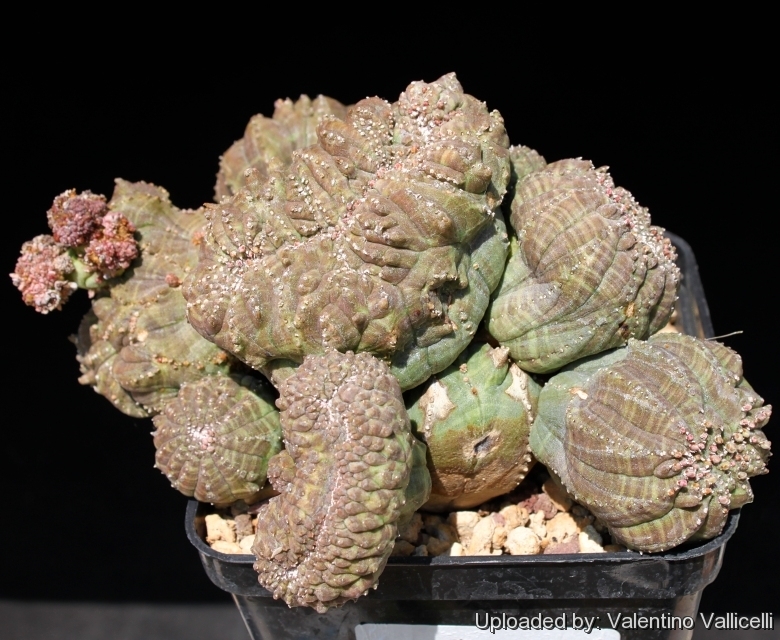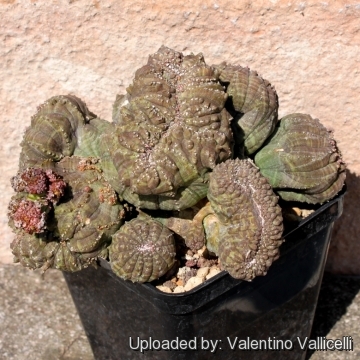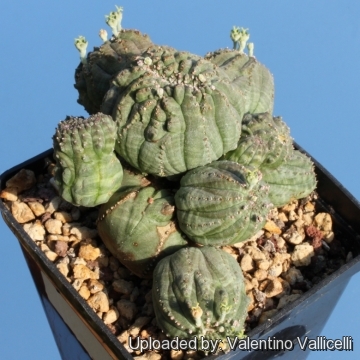




Your support is critical to our success.
- Encyclopedia of SUCCULENTS
- Encyclopedia Index
- Families
- Genera
- Species
- Euphorbiaceae
- Euphorbia
- Monstruos
- Crested
Since 4 Aug 2013
Accepted Scientific Name: Euphorbia obesa Hook.f.
Bot. Mag. 129: t. 7888. 1903

Origin and Habitat: Garden origin (Nursery produced cultivar)
Synonyms:
Euphorbia obesa Hook.f.
Bot. Mag. 129: t. 7888. 1903
Synonymy: 3
- Euphorbia obesa Hook.f.
- Euphorbia obesa f. cristata hort.
- Euphorbia obesa f. monstruosa cristata hort.
Euphorbia obesa subs. symmetrica (A.C.White, R.A.Dyer & B.Sloane) G.D.Rowley
Euphorbiaceae Study Group Bulletin 11(3): 97 (1998)
Synonymy: 2
- Euphorbia obesa subs. symmetrica (A.C.White, R.A.Dyer & B.Sloane) G.D.Rowley
- Euphorbia symmetrica A.C.White, R.A.Dyer & B.Sloane
Description: Euphorbia obesa f. monstruosa cristataSN|1966]]SN|22542]] is name used to indicate a number of clones with different monstrous and crested shapes. The stems slowly branch showing many growing variations, forming irregular mounded clumps often with several heads. This crested forms are rare and sought after by collectors, for their unique features. There are several and variously shaped and sized crested clones. Sometime monstrous and crested shapes are the result of injures or diseases.
Stem: Fan shaped, forming strange, tangled mounds, solid, firm, with a variable width of 2 to 10 cm, grey green, iron-grey, bluish-green or brown-green with very attractive transverse red-brown or dull purplish bands and with finely marked longitudinal seams marking its surface, creating an almost plaid effect.
Ribs: Broad, irregularly shaped, slightly raised with shallow furrows in between.
Leaves: The leaves are very rudimentary, minuscule and soon drop off
Flowers: This Euphorbia is unisexual with the small, greyish green cyathia normally being all male on some plants, or all female on others. Therefore cross pollination between a male and a female plant is required to produce seeds. Pollination usually carried out by insects. All euphorbias have a complex floral arrangement that is termed a cyathium (a cup) and this is the unit of the inflorescence. A cyathium contains many highly reduced male flowers or a single female flower. In Euphorbia obesaSN|22542]]SN|1966]], the cyathia appear in summer, from "circular flowering eyes", situated along the tops of the angles, near the growing tip, on the stem. They are produced on fork-branched peduncles (flower stalks), have minute bracts and are finely hairy. The cyathia are cup-shaped to 3 mm in diameter, expanding in the female.The tiny flowers are delicately scented
Fruits: The fruit is a slightly 3-angled capsule , up to 7 mm in diameter that explosively releases the seeds. The peduncles do not persist, and fall off after the seed has been dispersed.
Seeds: Small rounded 2 mm diameter mottled grey when mature.
Subspecies, varieties, forms and cultivars of plants belonging to the Euphorbia obesa group
 Euphorbia obesa Hook.f.: It is a highly succulent solitary plant without spines or leaves that looks like a green-brown football, but will sometimes 'branch' or sucker, creating very odd looking clusters of spheres.
Euphorbia obesa Hook.f.: It is a highly succulent solitary plant without spines or leaves that looks like a green-brown football, but will sometimes 'branch' or sucker, creating very odd looking clusters of spheres. Euphorbia obesa f. cristata hort.: plant with strong dark green fan-shaped crested branches forming a snaky ridge or crowded cluster.
Euphorbia obesa f. cristata hort.: plant with strong dark green fan-shaped crested branches forming a snaky ridge or crowded cluster. Euphorbia obesa f. monstruosa cristata hort.
Euphorbia obesa f. monstruosa cristata hort. Euphorbia obesa subs. symmetrica (A.C.White, R.A.Dyer & B.Sloane) G.D.Rowley: It forms beautifully flattened sphere with horizontal purplish banding and very similar to Euphorbia Obesa.
Euphorbia obesa subs. symmetrica (A.C.White, R.A.Dyer & B.Sloane) G.D.Rowley: It forms beautifully flattened sphere with horizontal purplish banding and very similar to Euphorbia Obesa. Euphorbia obesa cv. Prolifera: On top of the ribs are minute axillary shoots in a continuous series on each node of the stem .
Euphorbia obesa cv. Prolifera: On top of the ribs are minute axillary shoots in a continuous series on each node of the stem . Euphorbia obesa cv. Rocky Mountain
Euphorbia obesa cv. Rocky Mountain

Euphorbia obesa f. monstruosa cristata Photo by: Valentino Vallicelli

Euphorbia obesa f. monstruosa cristata Photo by: Valentino Vallicelli
Cultivation and Propagation: It is not too difficult in a greenhouse, although grows quite slowly. It is usually seen as a grafted plant but can grow on its own roots too.
Soil: Use a mineral well permeable soil with little organic matter (peat, humus).
Exposure: They need a good amount of light shade to full sun this help to keep the plants healthy, although slow growth.
Watering: Water sparingly from March till October (weekly during summertime, if the weather is sunny enough), with a little fertilizer added. Less or no water during cold winter months, or when night temperatures remain below 10° to prevent root loss. It is sensitive to overwatering (rot prone).
Fertilization: Feeding may not be necessary at all if the compost is fresh then, feed in summer only if the plant hasn't been repotted recently. Do not feed the plants from September onwards as this can cause lush growth which can be fatal during the darker cold months.
Hardiness: Keep perfectly dry in winter at temperatures from 5 to 15 degrees centigrade. (but it is relatively cold resistant and hardy to -5° C, or possibly colder for short periods) In the rest period no high atmospheric humidity!! (Temperature Zone: USDA 9-11)
Crested growth: Unlike 'monstrose' varieties of plants, where the variation from normal growth is due to genetic mutation, crested growth can occur on normal plants. Sometimes it's due to variances in light intensity, or damage, but generally the causes are unknown. A crested plant may have some areas growing normally, and a cresting plant that looks like a brain, may revert to normal growth for no apparent reason. If you have any of the crested part left you need to remove the normal growth and leave the crested part behind this will need to be done regularly.
Propagation: Grafting or cuttings. Plants are usually grafted onto column-shaped cacti but proved to be able to produce their own roots if degrafted. Cuttings will take root in a minimum temperature of 20° C (but better in hot weather). Cuttings of healthy shoots can be taken in the spring and summer. Cut the stem with a sharp, sterile knife, leave the cutting in a warm, dry place for a week or weeks (depending on how thick the cutting is) until a callus forms over the wound. Once the callus forms, the cutting may be inserted in a container filled with firmed cactus potting mix topped with a surface layer of coarse grit. They should be placed in the coarse grit only; this prevents the cut end from becoming too wet and allows the roots to penetrate the rich compost underneath. The cuttings should root in 2 to 6 weeks. Large crested piece must be placed on the soil surface without burying the plant base down in the soil.
| Your Actions | |
|---|---|
| Back to Euphorbia index | |
| Back to Euphorbiaceae index | |
 |
Back to Succulents Encyclopedia index |
Privacy stantement - Terms and conditions - How to cite - About us - Feedback - Donate



